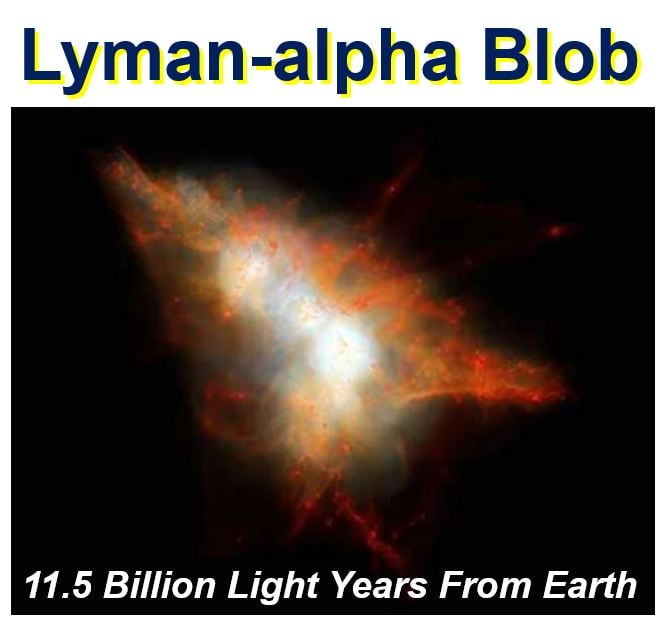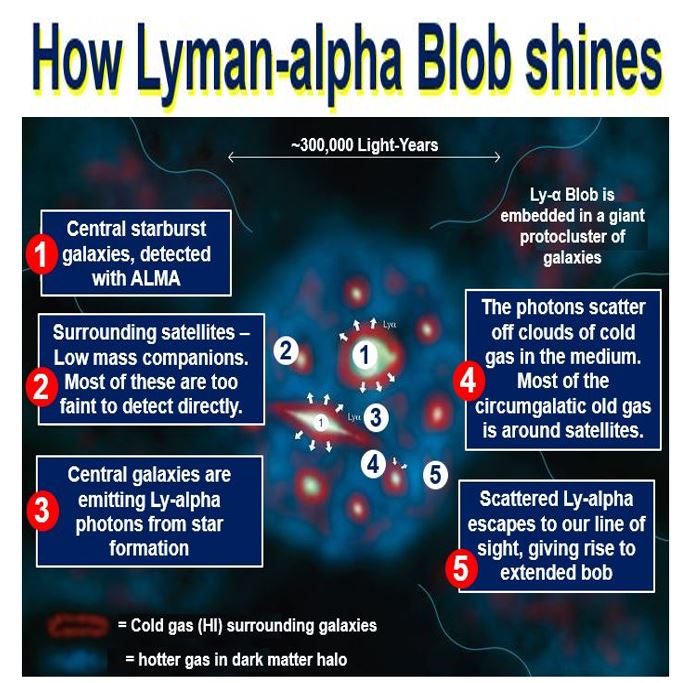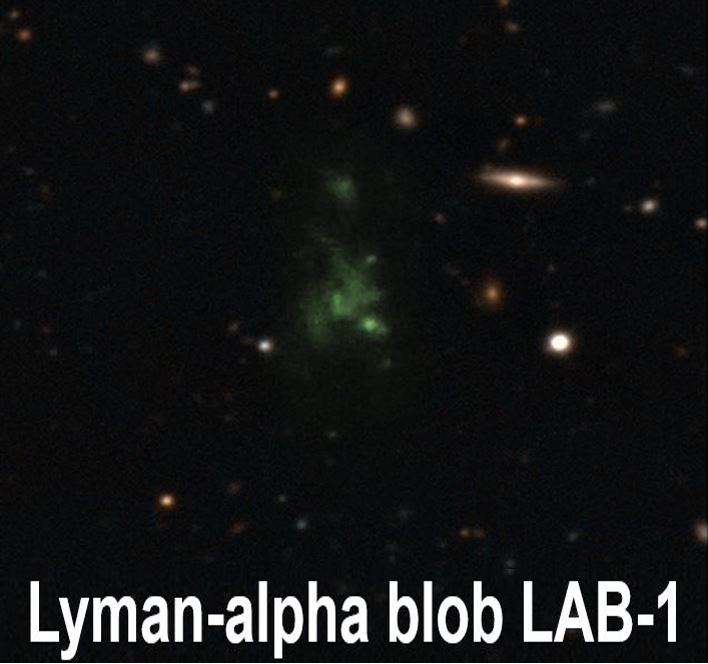The giant space blob mystery has finally been solved, says a team of scientists led by astronomers from the University of Hertfordshire in England. The LABS (Lyman-alpha Blobs) are huge clouds of hydrogen gas, several hundreds of thousands of light years across, that glow considerably more brightly than scientists expect.
The astronomers have written a paper which will be published in The Astrophysical Journal – it is currently posted in Arxiv.org (citation below), a repository of electronic preprints (e-prints).
Since these giant blobs were first discovered, the processes that make them glow so intensely has been a puzzle for astrophysicists, that is, until now. Study leader, Dr. James Geach, from the University of Hertfordshire’s Centre for Astrophysics Research, and colleagues have confirmed that baby galaxies are forming within these mega blobs, causing them to glow.
 At the heart of this blob two galaxies are being formed. According to the European Southern Observatory: “These large galaxies are in turn at the centre of a swarm of smaller ones in what appears to be an early phase in the formation of a massive cluster of galaxies. The two ALMA sources are expected to evolve into a single giant elliptical galaxy.” (Image: herts.ac.uk)
At the heart of this blob two galaxies are being formed. According to the European Southern Observatory: “These large galaxies are in turn at the centre of a swarm of smaller ones in what appears to be an early phase in the formation of a massive cluster of galaxies. The two ALMA sources are expected to evolve into a single giant elliptical galaxy.” (Image: herts.ac.uk)
The largest space blob we know of
SSA22-Lyman-alpha blob 1, also called LAB-1, is one of the largest LABs we know of. Dr. Geach and colleagues have found that two galaxies are forming within LAB-1. The blob is creating stars at an incredible rate – 100 times faster than the Milky Way (our galaxy) is.
The gas cloud glows so incredibly brightly because of this intense nature of star formation.
Dr. Geath, who was also lead author, said:
“Think of a streetlight on a foggy night – you see the diffuse glow because light is scattering off the tiny water droplets. A similar thing is happening here, except the streetlight is an intensely star-forming galaxy and the fog is a huge cloud of intergalactic gas. The galaxies are illuminating their surroundings.”
LAB-1 is extremely far from Earth
LAB-1, which was found fifteen years ago, was the very first object of its kind to be discovered. It is 11.5 billion light years from Earth – it takes 11.5 billion years for its light to reach us. LAB-1 measures 300,000 light years across and is three times the size of our Milky Way.
 The diagram above explains how a Lyman-alpha Blob – one of the biggest and brightest objects in the Universe – shines. (Image: eso.org. Credit: ESO/J. Geach)
The diagram above explains how a Lyman-alpha Blob – one of the biggest and brightest objects in the Universe – shines. (Image: eso.org. Credit: ESO/J. Geach)
To monitor such a mega mass, the research team, consisting of scientists from the UK, Japan, Sweden, Norway, the US, Canada, Spain and The Netherlands, used ALMA (the Atacama Large Millimeter/Submillimeter Array), comprising sixty-six 12-metre (39 ft) and 7-metre (23 ft) diameter radio telescopes observing at millimeter and submillimeter wavelengths, that can observe light from dust clouds in very distant galaxies several billions of light years from Earth.
This meant that the astronomers were accurately able to pinpoint several light and radiation sources within the space blob, where they detected two young, growing elliptical galaxies.
The ALMA images were then combined with observations from the MUSE (Multi Unit Spectroscopic Explorer) instrument that is mounted on the Southern Observatory’s VLT (Very Large Telescope).
The VLT maps the light that is emitted from the giant blob, known as Lyman-alpha light. It showed that the sources of light are the forming of stars in the very heart of this Lyman-alpha Blob.
Deep imaging with the NASA/ESA Hubble Space Telescope and spectroscopy at the W. M. Keck Observatory near the summit of Mauna Kea in Hawaii also showed that the ALMA sources are surrounded by several faint companion galaxies that could be bombarding the central ALMA sources with material, helping boost their high star formation rates.
 The Lyman-alpha blob LAB-1. This image is a composite of two different images. The intense Lyman-α ultraviolet radiation from the blob appears green after it has been stretched by the expansion of the Universe during its 11.5 billion-light-year journey to Earth. According to these new observations, the light from this object is polarised, which means that the giant ‘Blob’ must be powered by galaxies embedded within the cloud. (Image: eso.org. Credit: ESO/M. Hayes)
The Lyman-alpha blob LAB-1. This image is a composite of two different images. The intense Lyman-α ultraviolet radiation from the blob appears green after it has been stretched by the expansion of the Universe during its 11.5 billion-light-year journey to Earth. According to these new observations, the light from this object is polarised, which means that the giant ‘Blob’ must be powered by galaxies embedded within the cloud. (Image: eso.org. Credit: ESO/M. Hayes)
Dr. Geach added:said:
“What’s exciting about these blobs is that we are getting a rare glimpse of what’s happening around these young, growing galaxies. For a long time the origin of the extended Lyman-alpha light has been controversial.”
“But with the combination of new observations and cutting-edge simulations, we think we have solved a 15-year-old mystery: Lyman-alpha Blob-1 is the site of formation of a massive elliptical galaxy that will one day be the heart of a giant cluster. We are seeing a snapshot of the assembly of that galaxy 11.5 billion years ago.”
Citation: “ALMA observations of Lyman-α Blob 1: Halo sub-structure illuminated from within,” J. E. Geach, D. Narayanan, Y. Matsuda, M. Hayes, LL. Mas-Ribas, M. Dijkstra, C. C. Steidel, S. C. Chapman, R. Feldmann, A. Avison, O. Agertz, y. Ao, M. Birkinshaw, M. N. Bremer, D. L. Clements, H. Dannerbauer, D. Farrah, C. M. Harrison, N. K. Hine, M. Kubo, M. J. Michałowski, Douglas scott, d. J. B. Smith, m. Spaans, j. M. Simpson, a. M. Swinbank, y. Taniguchi, e. Van kampen, p. Van der Werf, A. Verma & T. Yamada. Currently posted in: arXiv:1608.02941v1 [astro-ph.GA] 9 Aug 2016. To be published soon in The Astrophysical Journal.
Video – Zooming in on a giant space Blob
This video zoom sequence, by the European Southern Observatory, starts with a wide-field view of the dim constellation of Aquarius and slowly closes in the Lyman-alpha blob LAB1.
